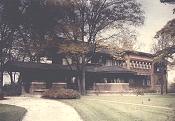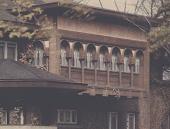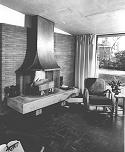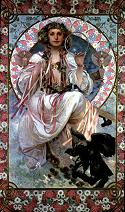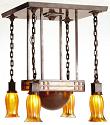|
|
|
Purcell and Elmslie, Architects Firm active :: 1907-1921
Minneapolis, Minnesota :: Chicago,
Illinois |
Ye Older Grindstones
3/25/2004
The first step. The great array of consciousness confluent in the work of Purcell and Elmslie can scarcely be itemized. There are hints, indeed many of them, among the writings of Purcell, of the philosophical and popular intellectual reservoirs of their day whose presence was recognizable (at least by the principals) entwined in the work of P&E. A curious bit of unknown information surfaced recently concerning Charles H. Hinton, and that brings us to the very threshold of something that both Purcell and Elmslie make specific mention of in their comments about the understanding and expression of organic consciousness.
Understand, my friends, that we tread here in dangerous and disreputable waters. Sort of like sailing a pleasure yacht these days in the South China Sea. We are going to have the temerity to discuss consciousness, which cannot be measured and by the "scientific" definitions of the materialists (read: the established paradigm) can have no reality. Yet, in reading these people and their rejections of the intangible, one wonders if it has ever crossed their minds that conscious awareness is in itself inexplicable within the system they proffer.
3/21/2004
Gerald Stanley Lee
Still working after all these years...Working it. Heavens, a month has passed since I worked on the site, part of which is due to an unrelenting respiratory infection. However, there have been interim developments. I acquired the biography of Gerald Stanley Lee by Gregory W. Bush, which is titled Lord of Attention: Gerald Stanley Lee & the Crowd Metaphor in Industrializing America (University of Massachusetts Press, 1991). Purcell wrote that Lee's The Voice of the Machines, published by Mount Tom Press in 1906, was an important text in understanding the sense of machine that went into P&E designs. Lee attempted to join the notion of democracy and industrialization as a poetic basis for life. He was entranced with the masses of people, speed and productivity, and blithely skipped over the tenements and souls crushed by repetitive assembly line work.
Gregory Bush spends about two pages on The Voice of the Machines, in which he describes favorable reactions to the book from William James ("Who on earth is G. S. Lee? Write me about him. He is a god like article, and he will be a new force in literature if only he doesn't degenerate into subjectivism and mannerism.") Ironically, Purcell made nearly the same comment with a slightly different vocabulary, in his Parabiographies n ote concerning two books significant to him in the late 1900s:
"In July, 1908, G.G.E. sent me a copy of "The Voice of the Machines." I opened it on a crowded Hennepin Avenue Street car on the way home and read the first chapter. It gave me such an emotional shock that the picture of the hot street car, jam of people, are deeply stained into my mind's film.
The author, Gerald Stanley Lee, and my frequent later personal contacts with him, provide the material for a most interesting and amusing portrait which I shall write for the year 1917. His book is an inspirational reaction to machinery and the contemporary world and will remain great reading for any mind that can sense reality through the whirl of actuality which confuses even the most level headed...
From "The Voice of the Machines," I tried Lee's "The Child and the Book," "Crowds," Inspired Millionaires," but they are top-heavy plants from too much watering and fertilizing from otherwise sound ideas. Had Lee's writing been digested by two-thirds its bulk, he might have been a great power. His "Crowds" was cut two-thirds and republished. It should have been cut another two-thirds.
His Mt. Tom magazine - a sort of personal "house organ" pamphlet, was excellent because the cost of printing kept his swarming words inside the school yard."At this point, it should be noted that the "swarming words" Purcell observes were the result of an effort by Lee to invoke the lyricism of Walt Whitman in support of his thesis about the "flocking" of crowds to the world of the machine. But, of course, "subjectivism" and "mannerism" also fit the ticket. And, for those counting, that's two biographies in a row of people Purcell knew that fail to mention him at all (see below).
One little thing came to hand recently that made me laugh. I bought a couple of cheap can lights at a hardware superstore, and noticed a curious thing when I opened the boxes. The art design for the packaging is obviously derivative of P&E stationery. I can only wonder how someone designing the graphics for something made in China came across the tesseract and finials. Naturally, the proportions have been changed and the poetry lost, but in some down sort of way it's kind of funny to see the influence continues to spread. How poetic that it is on the box for a device (are lamps considered machines?) that sheds light.
2/15/2004
Henry B. Babson Residence
Lumiere autochrome by Purcell, 1914
Detail, showing sleeping porch alterations
Fireplace
Prospect Avenue house
Pasadena 1946
Fireplace
Oscar Owre residence
Minneapolis, Minnesota
1911Tidiness. Many of the images on this site, and on the related pages of The Prairie School Exchange, have accumulated their electronic forms over the past decade. In terms of the technology, that's an aeon or two. Reviewing some pages, I noticed that very old scans were unnecessarily in place and I spent some time creating new ones. One advantage is having (slightly) better equipment than was earlier the case. Higher resolution scans can be manipulated to gain otherwise "lost" details. The Lumiere autochrome taken in 1914 by Purcell of the long-since demolished Henry B. Babson residence is a good demonstration. While the graininess of the original medium limits what can be achieved from even a good photographic print, it is possible to get a color sense of the various parts, as well as show the effects of leaded glass and other ornamentation. The depth of detail is just shy, however, of revealing the patterns of sawed wood. In another funny note, I recently came across one of the Babson wall sconces now hanging in a galley of the Los Angeles Museum of Art. A number of these objects appear in the images of the house served by the Library of Congress on their on their American Landscape and Architectural Design pages. Lo and behold, after twenty some years, I compare those images of correct placement with a photograph of a sample casting that hung upside down in the Purcell, Feick and Elmslie office--no doubt ported there by GGE when he decamped from Louis Sullivan's Auditorium Tower office.
I also came across a photo of the hearth designed by Purcell and James Van Evera Bailey for two small Modernist slipform concrete houses built on Prospect Avenue in Pasadena during the 1940s. These two buildings are exceedingly hard to find, being accessed by a private drive that is less visible than an alleyway alongside the Pasadena freeway. How very interesting is the elevated fireplace, such a clear in-line evolution from the many raised hearths built just thirty years before as one of the P&E signature elements. The extrusion of the fire platform is complete, elevated both from the earth (the twin blocks so commonly anchoring P&E fireplaces now fully functional in uplifting not only the eye but the fire itself; and the fire shelf extends completely out from the brick wall, which is refined to pure frame for the fireback. There's a poem of movement across three decades there.
2/13/2004
<-- Portrait of Josephine Crane Bradley by Alphonse Maria Mucha
Electrolier for the Josephine Crane Bradley residence #1Craning to catch a glimpse. Today arrived, thwarting a modest amount of anticipation, a book I could scarcely afford but bought anyway, Charles R. Crane: The Man Who Bet on People, by David Hapgood (XLibris, 2000). Nary a word within the gaunt body of the 102 pages of text about Sullivan, Purcell and Elmslie, the two Madison houses, or the Bradley Bungalow at Juniper Point (the Appendices, containing family notes and other documents about Crane's ambassadorial and other travels, run from page 106 to 243). The book is copyrighted by the Institute of Current World Affairs, a foundation set up by Crane, and written by the son of Norman Hapgood (1868-1937). This, at least, is interesting. Purcell corresponded with Norman Hapgood (1911-1912), who was editor of Collier's Weekly (mentioned in an earlier Grind)--serendipitously at the same time Charles R. Crane was having the Bungalow and all those other buildings done by P&E at the Woods Hole estate. Crane later funded the efforts of Hapgood and his wife to translate and publish the works of Stanlislavski. Indeed, while I was hoping for a weightier tome that examined the implications of the world stage where Crane proved such a powerful force for good, the monograph is much like a good watercolor. Alas, there is not a single illustration, save the dust cover portrait.
Instead, as with a nice post-prandial mint or--to honor Charles R. Crane--a fine Deglet Noor date, there is the final note of Crane's life: he died in Palm Springs in 1939, where he had a winter home for many years. Of course, Purcell had spent 1930-1936 in a tuberculosis sanatorium in nearby Banning, California, and built a little Modernist home on Ocotillo Drive in Palm Springs proper. It seems almost impossible to me that Purcell would not have fired off to Crane one of his inimitable postal card greetings which, in this period, would have likely borne a little water color sketch. Purcell cannot have been unaware of Crane's presence just next door. I wonder if such a document will ever turn up.
Josephine's husband, Harold C. Bradley, was a founding member and director of the Sierra Club. Papers related to his service (and possibly other personal papers, though I am as yet uncertain from the description) are described at a UC Berkeley web site for the Bancroft Library: "Bradley was president from 1957 to 1959 and a board member from 1951 to 1961. Papers include correspondence, arranged alphabetically by name of correspondent, and subject files, arranged alphabetically. Prominent correspondents include William E. Colby, Duncan M. McDuffie, Walter A. Starr, and Edgar Wayburn. Conservation issues treated in detail include dam-building in the Western United States; Dinosaur National Monument (Utah); Roads (especially proposed trans-Sierra Nevada routes); and Sierra Club committees" (Series 9: Harold C. Bradley Papers, 1911-1969 [Cartons 4-9]). A hagiographic (perhaps well-deserved) biography can be found at a University of Wisconsin site concerning a student housing which bears his name. The main Crane Estate page has been updated with these links and a color view of the early GGE "standard" hanging electrolier from an auction sale in 2001.




